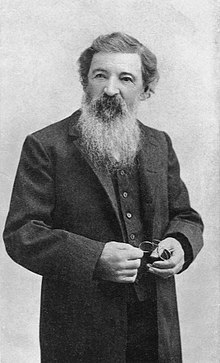Thomas Condon

Thomas Condon | |
|---|---|
 Thomas Condon at age 80 | |
| Born | 1822 |
| Died | 1907 (aged 84–85) near Eugene, Oregon, U.S.[2] |
| Resting place | Eugene Masonic Cemetery[3] |
| Nationality | Irish |
| Citizenship | United States |
| Alma mater | Auburn Theological Seminary |
| Occupation(s) | teacher, minister, geologist |
| Spouse | Cornelia Holt[4] |
| Children | 10[5] |
Thomas Condon (1822–1907) was an Irish Congregational minister, geologist, and paleontologist who gained recognition for his work in the U.S. state of Oregon.[6]
Life and career
[edit]Condon arrived in New York City from Ireland in 1833 and graduated from theological seminary in 1852, after which he traveled to Oregon by ship.[6] As a minister at The Dalles, he became interested in the fossils he found in the area.[6] He found fossil seashells on the Crooked River and fossil camels and other animals along the John Day River.[6] Many of his discoveries were in the present-day John Day Fossil Beds National Monument.[6] He corresponded with noted scientists, including Spencer Baird of the Smithsonian, Edward Cope of the Academy of Natural Sciences, Joseph Leidy, O.C. Marsh, and John C. Merriam,[7] and provided specimens to major museums.[6]
Condon was appointed the first State Geologist for Oregon in 1872.[8] He resigned that post to become first professor of geology at the University of Oregon. Previously he was a teacher at Pacific University in Forest Grove.[9]
In The Two Islands and What Came of Them, a geology book published in 1902, Condon wrote about two widely separated regions of Oregon that contain its oldest rocks, the Klamath Mountains in the southwestern part of the state and the Blue Mountains in the northeast.[10] The book attempted to summarize what was then known about the state's geology and to draw conclusions about its geologic past.[7]
Condon was an advocate of theistic evolution. He has been described as a "Christian Darwinist".[11]

Legacy
[edit]Condon Hall at the University of Oregon, which originally housed the geology department, was named for Condon,[12] as were the Thomas Condon Paleontology Center at the Sheep Rock unit of the John Day Fossil Beds National Monument, near Kimberly, Oregon,[13] temporary Lake Condon, formed periodically by the Missoula Floods, and the Condon Fossil Collection of the University of Oregon Museum of Natural and Cultural History, which was founded by Condon in 1876.[14] Condon Elementary School (1950-1983) in Eugene still stands as the University of Oregon's Agate Hall. He is the namesake of Condon Butte in Lane County.[15] Condon, Oregon, was named for Harvey C. Condon, a nephew of Thomas Condon.[16]
Anser condoni is a synonym for the fossil swan Cygnus paloregonus.[17]
See also
[edit]References
[edit]- ^ Clark, p. 2
- ^ Clark, p. 437
- ^ "Burials at Eugene Masonic Cemetery through 2010" (PDF). Eugene Masonic Cemetery. Retrieved June 28, 2011.
- ^ Clark, p. 75
- ^ Clark, pp. 190 and 238
- ^ a b c d e f Cogswell, Philip Jr. (1977). Capitol Names: Individuals Woven Into Oregon's History. Portland, Oregon: Oregon Historical Society. p. 103.
- ^ a b Orr, Elizabeth L.; Orr, William N. (1999). Geology of Oregon (5th ed.). Dubuque, Iowa: Kendall/Hunt Publishing Company. p. 13. ISBN 0-7872-6608-6.
- ^ "Administrative Overview". Oregon Department of Geology and Mineral Industries. July 1996. Retrieved February 18, 2012.
- ^ Bates, Henry L. (March 1920). "Pacific University". The Quarterly of the Oregon Historical Society. 21 (1). Portland, Oregon: Oregon Historical Society: 1–12.
- ^ Bishop, Ellen Morris (2003). In Search of Ancient Oregon. Portland, Oregon: Timber Press. p. 15. ISBN 978-0-88192-789-4.
- ^ Maynard, Guy; Holt, Kathleen. (2003). Best Essays NW: Perspectives from Oregon Quarterly Magazine. University of Oregon Press. p. 211. ISBN 9780871143037
- ^ Teague, Ed (June 1, 2004). "Condon Hall". University of Oregon. Retrieved June 15, 2011.
- ^ "Thomas Condon". November 28, 2017. Retrieved January 1, 2021.
- ^ "Condon Fossil Collection". University of Oregon. Archived from the original on July 21, 2011. Retrieved June 15, 2011.
- ^ "Indians, Surveyors, Incidents Gave Names to Streams, Lakes and Mountains". Eugene Register-Guard. 4 January 1942. p. 5. Retrieved 23 April 2015.
- ^ McArthur, Lewis A.; McArthur, Lewis L. (2003) [1928]. Oregon Geographic Names (7th ed.). Portland, Oregon: Oregon Historical Society Press. p. 224. ISBN 978-0875952772.
- ^ Brodkorb, Pierce (1964). "Catalogue of Fossil Birds: Part 2 (Anseriformes through Galliformes)". Bulletin of the Florida State Museum. 8 (3): 210. Retrieved January 1, 2021.
Works cited
[edit]- Clark, Robert D. The Odyssey of Thomas Condon (1989). Portland, Oregon: The Oregon Historical Society Press. ISBN 0-87595-200-3.
External links
[edit]- Dr. Thomas Condon from the Oregon Historical Society
- Thomas Condon profile from the Oregon Cultural Heritage Commission
- Thomas Condon biography from the National Park Service
- Thomas Condon: Of Faith and Fossils Documentary produced by Oregon Public Broadcasting